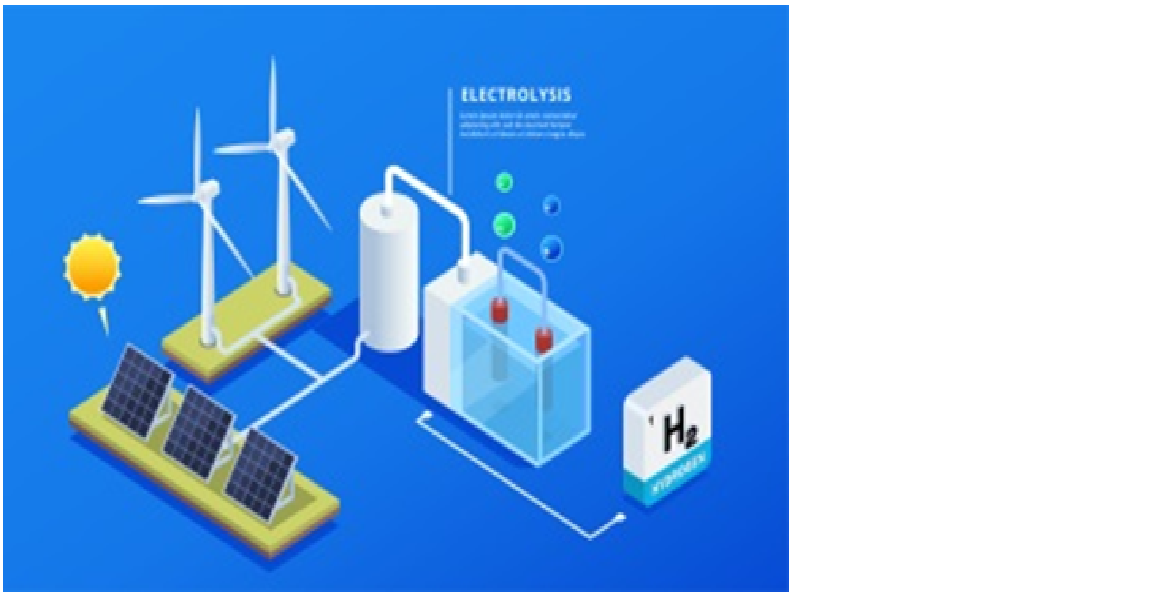Fueling a Clean Energy Future

Green Hydrogen has emerged a
powerful and viable solution as global efforts to fight climate change and
transition to sustainable energy increase. Often referred to as "fuel of
the future," Green Hydrogen is becoming more widely recognized as an
essential element in decarbonizing important economic sectors, reducing
dependency on fossil fuels, and facilitating long-term energy storage. It is a
key component of the sustainable energy landscape because of its capacity to
power entire cities, automobiles, and industries while producing no greenhouse
gas emissions.
Hydrogen is the most abundant
element in the universe, but it does not naturally exist in its pure form on
Earth. Hydrogen must be separated from other substances, mostly water or
hydrocarbons, in order to be used as a fuel. The environmental impact of an
extraction method is determined by its energy source and mode of use. Green
Hydrogen is produced using renewable energy sources to split water molecules,
generating hydrogen without releasing any carbon dioxide, making it the most
environmentally friendly form of Hydrogen available.The entire process becomes
carbon-neutral and environment friendly when Hydrogen is
produced from the electricity generated using renewable resources like
hydropower, wind or solar.
Chemical reaction:
2H2O(l)→2H2(g)+O2(g)
This reaction occurs inside an
electrolyzer, a device equipped with two electrodes (an anode and a cathode)
and an electrolyte that promotes the flow of ions. The method separates the
Hydrogen and Oxygen atoms in water by passing electricity through it. The
resulting Hydrogen gas can then be transported, stored, or used in fuel cells
to produce heat or electricity. Electrolyzers often use materials such as
platinum, iridium, or nickel as catalysts to enhance the efficiency of the
reaction, though these materials are costly and not always abundantly
available.
One of the major advantages of Green Hydrogen is its environmental impact—or rather, the lack of it. Because the process involves only water and renewable energy, Green Hydrogen production emits no carbon dioxide. Furthermore, when Hydrogen is used in fuel cells, the only byproduct is water vapor. This makes it ideal for decarbonizing hard-to-abate sectors like heavy industry (e.g., steel and cement manufacturing), long-haul transport, aviation, and even power generation. Green hydrogen also offers a way to store surplus renewable energy for later use, thereby improving the reliability of solar and wind power.
However, Green Hydrogen is not
without its challenges. The most important of these is its price. As of 2024,
the cost of producing Green Hydrogen is roughly $4–6 per kilogram, which is significantly
higher than the $1–2 per kilogram cost of producing Grey Hydrogen. The high
initial cost of electrolyzers, costly catalysts, and the scarcity of
inexpensive renewable electricity are the main causes of this pricing disparity.
Furthermore, producing Green Hydrogen necessitates the existence of a lot of
clean water, which is problematic in areas with limited water supplies, and
mining rare metals for electrolyzers has its own environmental costs.
India has taken significant measures
to establish itself as a global leader in this industry after realising the
revolutionary potential of Green Hydrogen. With an expenditure of ₹19,744 crore
(approx. $2.3 billion), the Indian government started the National Green
Hydrogen Mission in 2021 with the goal of developing a Green Hydrogen Mission
in 2021 with the goal of developing a Green Hydrogen ecosystem. The mission
sets an ambitious target of producing 5 million metric tonnes of green hydrogen
annually by 2030, supported by large-scale renewable energy deployment,
electrolyzer manufacturing, and policy incentives. Several Indian
states—including Gujarat, Karnataka, and Tamil Nadu—are developing green
hydrogen hubs, while public sector giants like NTPC and Indian Oil Corporation
are piloting green hydrogen projects in refining and heavy transport.
Globally, a number of nations are
spearheading the development of Green Hydrogen. With its National Hydrogen
Strategy and significant investments in international cooperation for Hydrogen
imports, Germany has taken the lead. Australia is becoming a significant exporter
of Green Hydrogen by utilizing its plentiful solar and wind resources. South
Korea and Japan are concentrating on infrastructure for Hydrogen fuelling and
automobiles powered by Hydrogen. Saudi
Arabia, through its futuristic NEOM city project, is planning one of the
world’s largest green hydrogen plants. The European Union has set a target to produce 10 million tonnes of
green hydrogen annually by 2030. On the corporate front, companies like Siemens
Energy, Air Liquide, Plug Power, and Nel ASA are pioneering technologies and
building large-scale green hydrogen infrastructure around the globe.
Conclusion
In conclusion, green hydrogen
represents a powerful tool in the global fight against climate change. Its
clean production process, versatility across industries, and ability to store
renewable energy give it a unique edge in the transition to a carbon-neutral
future. While current production costs and infrastructure limitations present
hurdles, ongoing technological advancements, policy support, and international
cooperation are steadily paving the way for green hydrogen to become a
cornerstone of the world’s sustainable energy systems.
Written By: PuspaKumari, Research Assistant, The Energy Forum.